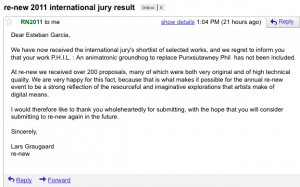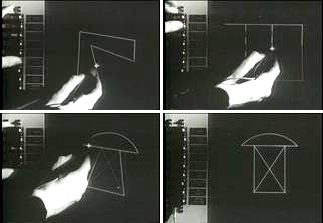During the past 40 years, graphics technologies have evolved from rudimentary images produced in room-sized computer labs to realistic simulated scenes diplayed in hand-held devices. Fast-paced advancement has been a defining characteristic of computer graphics and very little attention has been placed in the history of this emergent discipline. Society’s lure with new technologies drives today’s computer graphics consumer culture, represented by the film, gaming and software industries. We live in a world dominated by computer graphics aesthetics, but, what about when computers couldn’t do all this? How did this all happen?
I remember my first computer. It was a Commodore VIC20 that could be connected to the TV and produced graphics in a 22×23 matrix with only 16 colors. I used the BASIC language to program animations and the software LOGO to produce images like the one of an ice cream composed by 3 circles and a triangle. The VIC20 was a tool for home computing aimed for all ages, and it was a lot of fun. Nowadays I feel that computers, including mobile devices in this definition, are mainly consumer tools that do not encourage creativity. In a nostalgic way, I would like to revisit the days when computers were laboratories for the creativity and experimentation of the fathers of this discipline.
Visionaries from different areas ranging from the sciences to art and engineering found the computer as a tool for something more than repetitive tasks and calculations. Around the late 1960s, research enthusiasts from different universities sought to use the computer as an artistic tool. During this period, the hardware available was very limited and, programming languages were not robust, and difficult to program. Computers for visualization helped develop the concept of object-oriented programming, one of the most important features of contemporary computer languages. Examples of early visualization labs are the Electronic Visualization Lab (EVL) at the University of Chicago (UIC), Charles Csuri at the Ohio State University and Aldo Giorgini at Purdue University.
Aldo Giorgini was a pioneer in both computer graphics and the digital arts. His work designing the software FIELDS in 1975 is an important antecedent to the use of computers to aid artistic production. His contribution to computer graphics and the digital arts remains almost unknown, and his material legacy is at risk of disappearing. After his death in 1994, Giorgini’s materials remain untouched at his home-studio located in Lafayette, Indiana. Many of these documents present evidence of an engaged computer-aided art practice. The documents hold an untold history of a computer graphics visionary and I, as a researcher want to bring his contribution to the light. Unfortunately, many of the materials found that include, pen plotted prints, screen-prints, sketches, manuscripts, letters and printed code are not kept in optimum conditions from a preservation standpoint. Part of this research consists in finding the appropriate conditions to conserve digital art.

Learning about Aldo Giorgini’s approach to art and computer graphics will teach newer generations about our relationship with technology, and revive the spirit of creative experimentation with computers.
There is a lot of criticism to technology in our society, but from a Heidegger perspective, technology is nothing else that we already are. We cannot escape technology by denial, but we can seek for meanings. For this reason, writing an educational biography about Aldo Giorgini’s work in the digital arts is important to us today. This research will give the reader a framework to understand our living relationship with today’s technologies and their impact in the fine arts.
— Read more



